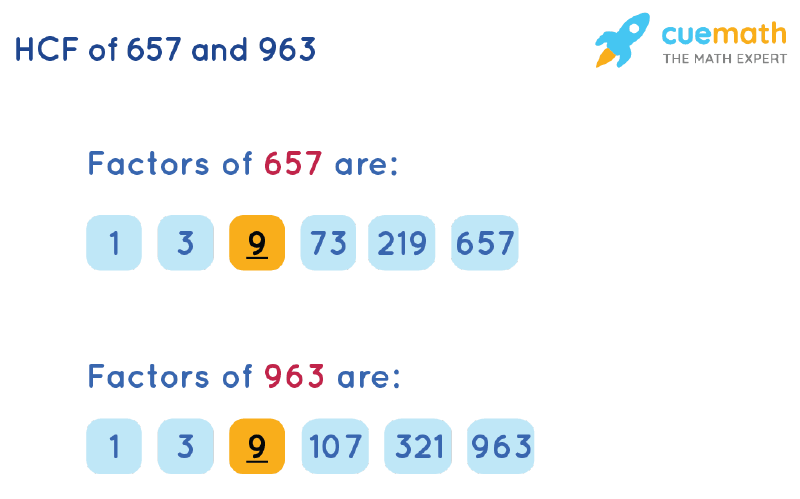HCF of 657 and 963
HCF of 657 and 963 is the largest possible number that divides 657 and 963 exactly without any remainder. The factors of 657 and 963 are 1, 3, 9, 73, 219, 657 and 1, 3, 9, 107, 321, 963 respectively. There are 3 commonly used methods to find the HCF of 657 and 963 - Euclidean algorithm, prime factorization, and long division.
| 1. | HCF of 657 and 963 |
| 2. | List of Methods |
| 3. | Solved Examples |
| 4. | FAQs |
What is HCF of 657 and 963?
Answer: HCF of 657 and 963 is 9.

Explanation:
The HCF of two non-zero integers, x(657) and y(963), is the highest positive integer m(9) that divides both x(657) and y(963) without any remainder.
Methods to Find HCF of 657 and 963
Let's look at the different methods for finding the HCF of 657 and 963.
- Prime Factorization Method
- Listing Common Factors
- Long Division Method
HCF of 657 and 963 by Prime Factorization
Prime factorization of 657 and 963 is (3 × 3 × 73) and (3 × 3 × 107) respectively. As visible, 657 and 963 have common prime factors. Hence, the HCF of 657 and 963 is 3 × 3 = 9.
HCF of 657 and 963 by Listing Common Factors

- Factors of 657: 1, 3, 9, 73, 219, 657
- Factors of 963: 1, 3, 9, 107, 321, 963
There are 3 common factors of 657 and 963, that are 1, 3, and 9. Therefore, the highest common factor of 657 and 963 is 9.
HCF of 657 and 963 by Long Division
HCF of 657 and 963 is the divisor that we get when the remainder becomes 0 after doing long division repeatedly.
- Step 1: Divide 963 (larger number) by 657 (smaller number).
- Step 2: Since the remainder ≠ 0, we will divide the divisor of step 1 (657) by the remainder (306).
- Step 3: Repeat this process until the remainder = 0.
The corresponding divisor (9) is the HCF of 657 and 963.
☛ Also Check:
- HCF of 27 and 36 = 9
- HCF of 5, 10 and 15 = 5
- HCF of 398, 436 and 542 = 2
- HCF of 18 and 42 = 6
- HCF of 6 and 20 = 2
- HCF of 36 and 48 = 12
- HCF of 36 and 84 = 12
HCF of 657 and 963 Examples
-
Example 1: For two numbers, HCF = 9 and LCM = 70299. If one number is 657, find the other number.
Solution:
Given: HCF (z, 657) = 9 and LCM (z, 657) = 70299
∵ HCF × LCM = 657 × (z)
⇒ z = (HCF × LCM)/657
⇒ z = (9 × 70299)/657
⇒ z = 963
Therefore, the other number is 963. -
Example 2: The product of two numbers is 632691. If their HCF is 9, what is their LCM?
Solution:
Given: HCF = 9 and product of numbers = 632691
∵ LCM × HCF = product of numbers
⇒ LCM = Product/HCF = 632691/9
Therefore, the LCM is 70299. -
Example 3: Find the HCF of 657 and 963, if their LCM is 70299.
Solution:
∵ LCM × HCF = 657 × 963
⇒ HCF(657, 963) = (657 × 963)/70299 = 9
Therefore, the highest common factor of 657 and 963 is 9.

FAQs on HCF of 657 and 963
What is the HCF of 657 and 963?
The HCF of 657 and 963 is 9. To calculate the Highest common factor of 657 and 963, we need to factor each number (factors of 657 = 1, 3, 9, 73, 219, 657; factors of 963 = 1, 3, 9, 107, 321, 963) and choose the highest factor that exactly divides both 657 and 963, i.e., 9.
What is the Relation Between LCM and HCF of 657, 963?
The following equation can be used to express the relation between LCM (Least Common Multiple) and HCF of 657 and 963, i.e. HCF × LCM = 657 × 963.
What are the Methods to Find HCF of 657 and 963?
There are three commonly used methods to find the HCF of 657 and 963.
- By Long Division
- By Listing Common Factors
- By Prime Factorization
If the HCF of 963 and 657 is 9, Find its LCM.
HCF(963, 657) × LCM(963, 657) = 963 × 657
Since the HCF of 963 and 657 = 9
⇒ 9 × LCM(963, 657) = 632691
Therefore, LCM = 70299
☛ Highest Common Factor Calculator
How to Find the HCF of 657 and 963 by Long Division Method?
To find the HCF of 657, 963 using long division method, 963 is divided by 657. The corresponding divisor (9) when remainder equals 0 is taken as HCF.
How to Find the HCF of 657 and 963 by Prime Factorization?
To find the HCF of 657 and 963, we will find the prime factorization of the given numbers, i.e. 657 = 3 × 3 × 73; 963 = 3 × 3 × 107.
⇒ Since 3, 3 are common terms in the prime factorization of 657 and 963. Hence, HCF(657, 963) = 3 × 3 = 9
☛ What are Prime Numbers?
visual curriculum